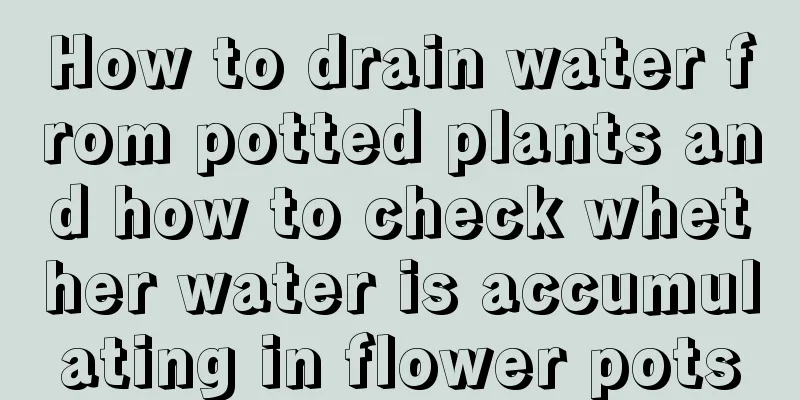How to drain water from potted plants and how to check whether water is accumulating in flower pots

1. How to drain water from potted plants1. There is water accumulation in the bottom tray If it is a smaller potted plant that can be moved, just pour out the water in the bottom tray. If it is a larger potted plant that is difficult to move, you can use a large syringe to drain the water from the tray, or you can replace the bottom tray with a bottom tray that can collect water. 2. Raise the pelvic floor If the gap between the flower pot and the base is too small, the air permeability of the flower pot will be poor. At this time, you can use bottle caps or other flat objects to pad between the flower pot and the base to increase air permeability so that the accumulated water can be drained quickly. 3. Drilling holes in the basin wall If it is a plastic flower pot, the air permeability will be relatively poor. Especially in summer, watering can easily cause water to accumulate in the pot, making the bottom impermeable. At this time, you can drill holes in the basin wall to help the accumulated water drain quickly. It should be noted that the size of the hole should be appropriate and not too large, so as to avoid exposing the soil in the pot after watering. 4. Add a breathable layer Adding dry needles, broken bricks and tiles, expanded clay, willow branches, charcoal and other things to the bottom of the pot or the soil to add a breathable layer to the potted plants can effectively prevent water accumulation in the pot and also help drain the accumulated water. 5. Loosen the soil When the soil in the pot is waterlogged, you can loosen the soil. Insert the loosening tool around the flowerpot and gently shake the soil to loosen it, increase the air permeability of the soil, and drain the accumulated water in the pot. 2. How to judge whether the flower pot is waterloggedWater the plant when the weather is nice and sunny, and then observe the soil in the pot the next day. If the soil in the pot becomes dry and appears slightly white, there is no water accumulation in the pot; if the soil in the pot remains moist, there may be water accumulation in the pot; if the soil in the pot remains moist after 3-5 days, it means that there is serious water accumulation in the soil and the roots may have rot problems. |
<<: How can gourds bear more fruits? How to cultivate gourds so that they can bear more fruits
Recommend
How to cultivate the rich child
Growth conditions of the rich fruit The soil for ...
Where is it suitable to grow apricots?
Apricot Growing Area Apricot trees do not have hi...
What does Nanzhi mean?
1. The meaning of gardenia 1. Purity: It describe...
Are snapdragon and goldfish spider plant the same plant?
Are snapdragon and goldfish spider plant the same...
How to propagate Magnolia
1. Grafting method (1) Time selection: Generally ...
Crape Myrtle Tree Price, Crape Myrtle Tree Pictures
1. Price of Crape Myrtle Tree The price of the cr...
How many years can Verbena be grown?
1. How many years can it be raised? Verbena is lo...
How to propagate banyan trees
Cuttings Banyan tree cuttings are usually chosen ...
Does pepper tree prefer shade or sun?
Does pepper tree prefer shade or sun? Pepperwood ...
How to grow and water the money tree
The money tree is currently a popular large indoo...
How to propagate Tiger Eye Dieffenbachia
Bulb division propagation of Ornithogalum Tiger e...
How to grow ginger lotus in winter? Do you need to cut the leaves?
1. Winter maintenance methods 1. Temperature: It ...
How to grow gardenia well
1. Moist soil Gardenia is not suitable for growin...
When is the latest time to plant onions?
Green onion is a common vegetable that is cold-re...
Can the osmanthus be repotted in summer? Things to note when repotting (watering tips)
Can the pot of the catnip be changed in summer? T...









